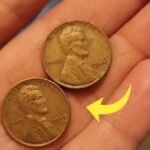The Lincoln Wheat Penny: A small copper coin often ignored in pockets or jars has today turned into one of the most valuable treasures in American coin history. The Lincoln Wheat Penny, especially the 1943 copper variant, has astonished collectors by selling for as much as $815,000 at auction. Originally minted as a one-cent coin, its immense value now lies in a unique historical mistake, extreme rarity, and collector demand. While most people overlook old pennies, this specific version has become a legendary piece in the world of rare coins, still possibly sitting unnoticed in circulation.
Lincoln Wheat Penny History
The Lincoln Wheat Penny was introduced in 1909 to commemorate the 100th birth anniversary of President Abraham Lincoln. It was the first circulating US coin to feature a real person instead of symbolic figures like Lady Liberty. Its reverse design included two wheat ears, giving rise to the name “Wheat Penny.” This design remained until 1958 and reflected the era’s strong identity and values. Over time, this coin became a historic symbol and a centerpiece for collectors due to its cultural significance and detailed artwork.
1943 Copper Penny Value
During World War II in 1943, copper was urgently needed for military use, so the US Mint used zinc-coated steel for pennies that year. However, a few copper planchets from 1942 accidentally got used in the presses. These copper 1943 pennies are now among the rarest American coins, with only about 20 to 30 known to exist. One such coin, preserved in mint condition, sold for $815,000. Its high value comes from the mistake that created it and the extremely low number of surviving examples today.
Other Rare Lincoln Pennies
Aside from the 1943 copper penny, there are other valuable variants of the Lincoln Wheat Penny. The 1909-S VDB is one of the earliest and most sought-after issues due to its limited mintage. The 1914-D penny from the Denver Mint, the 1922 No D penny, and the 1931-S penny are also considered rare and valuable. Additionally, coins with “double-die” errors—where the design appears doubled—can also fetch tens of thousands of dollars depending on their condition and demand in the collector market.
How to Identify Rare Pennies
To know if you have a valuable penny, look for coins dated between 1909 and 1958 with two wheat stalks on the back. Check the year and also the mint mark, such as ‘S’ for San Francisco or ‘D’ for Denver. The 1943 copper penny looks brown instead of silver and does not stick to a magnet. If your 1943 penny is not magnetic, it might be copper, which means it could be extremely valuable. Always check both front and back for mint errors or double designs, which increase the coin’s worth significantly.
Coin Condition and Certification
The true value of a coin also depends heavily on its condition and professional certification. Coins that are worn, scratched, or damaged are often less valuable, even if rare. Collectors rely on grading services like PCGS and NGC, which provide authentication and assign grades from Poor to Mint State. A certified coin in excellent condition may be worth 10 to 100 times more than the same coin in average shape. This grading is essential when selling or auctioning rare pennies for top dollar.
Why Old Coins Still Matter
The Lincoln Wheat Penny is more than just a collector’s item—it’s a reminder of American history and values. Holding such a coin offers a direct link to an era of change, war, and economic transformation. Some of these pennies were created during global conflict, adding to their emotional and historical depth. Even in today’s digital economy, the thrill of discovering a valuable coin in circulation remains strong, especially when these treasures could be hiding in plain sight within your change jar or old wallet.
Collecting Rare Pennies Today
Getting into coin collecting doesn’t require a big investment. Many collectors start by searching rolls of coins from banks or checking old jars and drawers at home. Begin by identifying Lincoln Wheat Pennies from 1909–1958 and compare them with rare year lists available online. Once familiar, you can visit coin shows, online auctions, or join collector forums to expand your knowledge. As you gain experience, your chances of finding or trading valuable coins increase. All it takes is observation and a bit of research.
A Penny That Could Change Your Life
Even in 2025, stories surface of people finding extremely rare pennies while cleaning or sorting through change. The 1943 copper penny and other rare Lincoln Wheat variants are still believed to be out there. Many collectors and investors actively search coin lots, estate sales, and flea markets hoping for the next lucky find. With the right coin, a simple penny could turn into an $800,000 payday. All it takes is curiosity, awareness, and a keen eye for details.
Disclaimer: The information in this article is based on publicly available data and should not be taken as financial or investment advice. Coin values depend on rarity, demand, condition, and market trends. Always consult certified experts before buying or selling rare coins.




